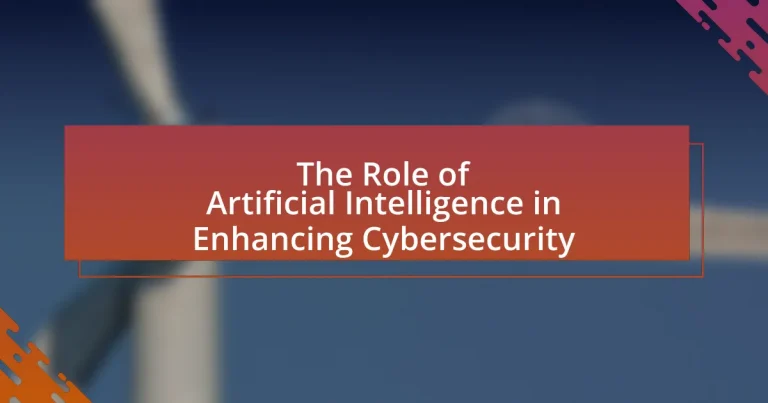Artificial Intelligence (AI) plays a pivotal role in enhancing cybersecurity by automating threat detection and response, significantly improving the efficiency of security measures. AI algorithms analyze large datasets to identify patterns and anomalies indicative of cyber threats, enabling organizations to respond to potential breaches in real-time. Key technologies involved include machine learning, natural language processing, and behavioral analytics, which collectively enhance predictive capabilities and reduce the time to detect and respond to threats. Despite its advantages, the integration of AI in cybersecurity faces challenges such as data privacy concerns, algorithmic bias, and the need for high-quality training data. Organizations can effectively implement AI by following best practices, assessing readiness, and investing in staff training to adapt to evolving cyber threats.

What is the Role of Artificial Intelligence in Enhancing Cybersecurity?
Artificial Intelligence plays a crucial role in enhancing cybersecurity by automating threat detection and response, thereby improving the efficiency and effectiveness of security measures. AI algorithms analyze vast amounts of data to identify patterns and anomalies that may indicate cyber threats, enabling organizations to respond to potential breaches in real-time. For instance, a report by McKinsey & Company highlights that AI can reduce the time to detect and respond to threats by up to 90%, significantly mitigating the impact of cyberattacks. Additionally, AI-driven systems can continuously learn from new data, adapting to evolving threats and improving their predictive capabilities, which is essential in the dynamic landscape of cybersecurity.
How does Artificial Intelligence contribute to cybersecurity measures?
Artificial Intelligence enhances cybersecurity measures by enabling real-time threat detection and response. AI algorithms analyze vast amounts of data to identify patterns indicative of cyber threats, allowing for quicker identification of anomalies compared to traditional methods. For instance, a study by IBM found that organizations using AI for cybersecurity can reduce the time to detect a breach from 197 days to just 21 days. Additionally, AI-driven systems can automate responses to common threats, minimizing human error and improving overall security posture.
What are the key technologies involved in AI-driven cybersecurity?
The key technologies involved in AI-driven cybersecurity include machine learning, natural language processing, and behavioral analytics. Machine learning algorithms analyze vast amounts of data to identify patterns and anomalies, enabling proactive threat detection. Natural language processing assists in understanding and responding to security threats by analyzing unstructured data, such as emails and social media. Behavioral analytics monitors user behavior to detect deviations that may indicate a security breach. These technologies collectively enhance the ability to predict, detect, and respond to cyber threats effectively.
How does AI improve threat detection and response?
AI improves threat detection and response by utilizing advanced algorithms to analyze vast amounts of data in real-time, identifying patterns and anomalies that indicate potential threats. For instance, machine learning models can process network traffic data to detect unusual behavior, such as unauthorized access attempts or data exfiltration, with a speed and accuracy that surpasses traditional methods. According to a report by the Ponemon Institute, organizations using AI for threat detection can reduce the average time to identify a breach from 206 days to just 18 days, significantly enhancing their response capabilities. This rapid identification allows cybersecurity teams to act swiftly, mitigating potential damage and improving overall security posture.
What are the main benefits of integrating AI into cybersecurity?
Integrating AI into cybersecurity significantly enhances threat detection and response capabilities. AI algorithms can analyze vast amounts of data in real-time, identifying patterns and anomalies that may indicate a security breach. For instance, a study by McKinsey & Company found that AI can reduce the time to detect a breach from months to minutes, thereby minimizing potential damage. Additionally, AI-driven systems can automate repetitive tasks, allowing cybersecurity professionals to focus on more complex issues, which increases overall efficiency. Furthermore, AI can adapt and learn from new threats, continuously improving its defensive measures, as evidenced by research from the Ponemon Institute, which reported that organizations using AI in their cybersecurity strategies experienced a 30% reduction in security incidents.
How does AI enhance the efficiency of security operations?
AI enhances the efficiency of security operations by automating threat detection and response processes. This automation allows security teams to analyze vast amounts of data in real-time, identifying anomalies and potential threats much faster than human analysts. For instance, AI algorithms can process network traffic and user behavior patterns to flag suspicious activities, reducing the time to detect and respond to incidents. According to a report by IBM, organizations using AI in their security operations can reduce the time to identify a breach by 27% and the time to contain a breach by 30%. This significant improvement in response times directly correlates with enhanced operational efficiency in cybersecurity.
What impact does AI have on reducing false positives in threat detection?
AI significantly reduces false positives in threat detection by utilizing advanced algorithms and machine learning techniques to analyze vast amounts of data more accurately than traditional methods. These AI systems can learn from historical data, identify patterns, and distinguish between legitimate threats and benign activities, leading to a more precise identification of actual threats. For instance, a study by IBM found that AI-driven security systems can reduce false positives by up to 90%, thereby allowing security teams to focus on genuine threats rather than wasting resources on false alarms. This enhanced accuracy not only improves operational efficiency but also strengthens overall cybersecurity posture.

What challenges does the integration of AI in cybersecurity face?
The integration of AI in cybersecurity faces challenges such as data privacy concerns, algorithmic bias, and the need for high-quality training data. Data privacy concerns arise because AI systems often require access to sensitive information to function effectively, which can lead to potential breaches. Algorithmic bias can result in AI systems making inaccurate predictions or decisions based on flawed data, leading to ineffective security measures. Additionally, the effectiveness of AI in cybersecurity heavily relies on the availability of high-quality training data; without it, AI models may not perform optimally, increasing vulnerability to cyber threats.
How do data privacy concerns affect AI in cybersecurity?
Data privacy concerns significantly impact the deployment and effectiveness of AI in cybersecurity by necessitating stricter compliance with regulations and ethical standards. Organizations must ensure that AI systems do not compromise personal data, which can limit the data available for training algorithms and hinder their performance. For instance, the General Data Protection Regulation (GDPR) in Europe imposes strict guidelines on data usage, requiring organizations to anonymize or minimize personal data collection, thereby affecting the breadth of data that AI can analyze for threat detection. This regulatory landscape can lead to challenges in developing robust AI models that require large datasets to learn and adapt effectively to evolving cyber threats.
What measures can be taken to ensure data protection while using AI?
To ensure data protection while using AI, organizations should implement robust encryption methods for data at rest and in transit. Encryption secures sensitive information, making it unreadable to unauthorized users. According to a 2021 report by the Ponemon Institute, organizations that employ encryption experience 50% fewer data breaches compared to those that do not. Additionally, regular audits and compliance checks with data protection regulations, such as GDPR, are essential to maintain accountability and transparency in AI systems. These measures collectively enhance the security posture of AI applications and protect user data effectively.
How can organizations address the ethical implications of AI in cybersecurity?
Organizations can address the ethical implications of AI in cybersecurity by implementing transparent AI systems that prioritize fairness, accountability, and privacy. Transparency allows stakeholders to understand how AI algorithms make decisions, which is crucial for building trust. Fairness ensures that AI systems do not discriminate against any group, while accountability involves establishing clear guidelines for AI usage and decision-making processes. Additionally, organizations should conduct regular audits and assessments of their AI systems to identify and mitigate biases, as evidenced by studies showing that biased algorithms can lead to significant ethical breaches. By fostering a culture of ethical AI use, organizations can enhance their cybersecurity measures while upholding moral standards.
What are the limitations of AI in cybersecurity?
AI in cybersecurity has several limitations, including its reliance on historical data, which can lead to biases and inaccuracies in threat detection. For instance, AI systems may struggle to identify novel threats that do not resemble past attacks, resulting in potential vulnerabilities. Additionally, AI can be susceptible to adversarial attacks, where malicious actors manipulate input data to deceive the AI, undermining its effectiveness. Furthermore, the complexity of AI algorithms can hinder transparency and interpretability, making it challenging for cybersecurity professionals to understand decision-making processes. These limitations highlight the need for human oversight and continuous improvement in AI systems to enhance their reliability in cybersecurity contexts.
How does the reliance on AI create potential vulnerabilities?
The reliance on AI creates potential vulnerabilities by introducing risks associated with algorithmic bias, data privacy breaches, and adversarial attacks. AI systems often depend on large datasets, which can contain biased information, leading to skewed decision-making processes that may overlook critical security threats. Additionally, the use of AI in cybersecurity can expose sensitive data to breaches if the algorithms are not properly secured, as seen in incidents where AI models were compromised, resulting in unauthorized access to confidential information. Furthermore, adversarial attacks can manipulate AI systems by feeding them deceptive inputs, which can lead to incorrect threat assessments and responses. These vulnerabilities highlight the need for robust safeguards and continuous monitoring to mitigate risks associated with AI in cybersecurity.
What are the risks of adversarial attacks on AI systems?
Adversarial attacks on AI systems pose significant risks, including compromised decision-making, data integrity issues, and increased vulnerability to exploitation. These attacks manipulate input data to deceive AI models, leading to incorrect outputs that can have severe consequences in critical applications such as autonomous vehicles, healthcare diagnostics, and security systems. For instance, a study by Szegedy et al. (2014) demonstrated that small perturbations in image data could lead to misclassification by deep learning models, highlighting the potential for adversarial examples to undermine trust in AI systems. Additionally, the National Institute of Standards and Technology (NIST) has identified adversarial machine learning as a key area of concern, emphasizing the need for robust defenses against such threats to ensure the reliability and safety of AI applications in cybersecurity.

How can organizations effectively implement AI in their cybersecurity strategies?
Organizations can effectively implement AI in their cybersecurity strategies by integrating machine learning algorithms to analyze vast amounts of data for threat detection and response. This approach allows for real-time monitoring and identification of anomalies that may indicate cyber threats, significantly improving incident response times. For instance, according to a report by McKinsey, organizations that utilize AI for cybersecurity can reduce the time to detect breaches by up to 80%. Additionally, deploying AI-driven tools for automated threat intelligence can enhance predictive capabilities, enabling organizations to proactively address vulnerabilities before they are exploited.
What best practices should organizations follow when adopting AI for cybersecurity?
Organizations should follow best practices such as conducting a thorough risk assessment, ensuring data privacy and compliance, and implementing continuous monitoring when adopting AI for cybersecurity. A comprehensive risk assessment helps identify vulnerabilities and tailor AI solutions effectively. Ensuring data privacy and compliance with regulations like GDPR protects sensitive information and builds trust. Continuous monitoring allows organizations to adapt to evolving threats and improve AI models based on real-time data, enhancing overall security posture. These practices are supported by industry standards and frameworks, such as the NIST Cybersecurity Framework, which emphasizes risk management and continuous improvement in cybersecurity strategies.
How can organizations assess their readiness for AI integration?
Organizations can assess their readiness for AI integration by evaluating their existing technological infrastructure, workforce skills, and data management practices. A thorough analysis of current systems reveals whether they can support AI technologies, while assessing employee expertise identifies gaps in skills necessary for effective AI implementation. Additionally, organizations should examine their data quality and availability, as AI systems require large volumes of accurate data to function optimally. According to a McKinsey report, 70% of organizations that successfully integrate AI have a strong data foundation, highlighting the importance of data readiness in the assessment process.
What training is necessary for staff to effectively use AI tools in cybersecurity?
Staff must undergo specialized training in AI fundamentals, machine learning algorithms, and cybersecurity principles to effectively use AI tools in cybersecurity. This training should include hands-on experience with AI software, understanding data privacy regulations, and developing skills in threat detection and response using AI technologies. Research indicates that organizations that invest in comprehensive AI training for their cybersecurity teams see a 30% improvement in incident response times and a 25% reduction in security breaches, demonstrating the effectiveness of such training programs.
What future trends can we expect in AI and cybersecurity?
Future trends in AI and cybersecurity include the increased use of machine learning algorithms for threat detection and response, as well as the integration of AI-driven automation in security operations. Machine learning models can analyze vast amounts of data to identify anomalies and potential threats in real-time, significantly improving incident response times. According to a report by Gartner, by 2025, 75% of organizations will use AI-based security solutions, reflecting a shift towards proactive rather than reactive cybersecurity measures. Additionally, AI will enhance predictive analytics, allowing organizations to anticipate and mitigate cyber threats before they occur, thereby reducing the overall risk landscape.
How will advancements in AI technology shape the future of cybersecurity?
Advancements in AI technology will significantly enhance cybersecurity by enabling faster threat detection and response. AI algorithms can analyze vast amounts of data in real-time, identifying patterns and anomalies that indicate potential security breaches. For instance, according to a report by McKinsey, AI can reduce the time to detect a breach from days to minutes, thereby minimizing damage. Additionally, machine learning models can adapt and improve over time, becoming more effective at predicting and preventing cyber threats. This capability is crucial as cyberattacks become increasingly sophisticated, with a 2021 Cybersecurity Ventures report predicting that cybercrime will cost the world $10.5 trillion annually by 2025. Thus, the integration of AI in cybersecurity is not only a trend but a necessary evolution to combat the growing complexity of cyber threats.
What role will machine learning play in evolving cybersecurity threats?
Machine learning will significantly enhance the sophistication and frequency of cybersecurity threats. As machine learning algorithms become more advanced, cybercriminals will leverage these technologies to automate attacks, analyze vast amounts of data for vulnerabilities, and develop adaptive malware that can evade traditional security measures. For instance, a report by McAfee in 2020 indicated that machine learning is increasingly used in phishing attacks, where attackers utilize AI to craft personalized messages that are more likely to deceive victims. This evolution in threat tactics underscores the need for cybersecurity defenses to also incorporate machine learning to detect and respond to these emerging threats effectively.
What practical steps can organizations take to enhance cybersecurity with AI?
Organizations can enhance cybersecurity with AI by implementing machine learning algorithms for threat detection and response. These algorithms analyze vast amounts of data to identify patterns indicative of cyber threats, enabling real-time alerts and automated responses. For instance, a study by IBM found that organizations using AI for cybersecurity can reduce the time to identify and contain a breach by 27% compared to those that do not. Additionally, organizations should deploy AI-driven security information and event management (SIEM) systems that aggregate and analyze security data from across the network, providing comprehensive visibility and faster incident response. By integrating AI into their cybersecurity frameworks, organizations can significantly improve their ability to predict, detect, and respond to cyber threats effectively.




